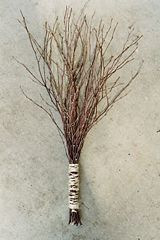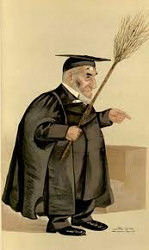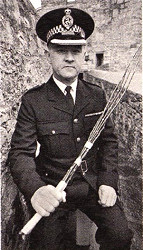The Library of Spanking Fiction: Wellred Weekly
|
||||||
|
Articles
Items of interest regarding all things spanking
|
||||||
|
|
The Birch The Birch Rod  Throughout written history up to the 19th century, the birch rod was the most popular spanking implement in Europe. The birch rod, sometimes simply referred to as the birch, is a bundle of thin leafless twigs bound together to form an implement for the purpose of flagellation. Contrary to the name, a birch rod is not a single rod but a cluster of birch twigs tied together to form a long handle, whilst leaving an open splay of twigs (or withes) at the 'business end' of the implement. Throughout written history up to the 19th century, the birch rod was the most popular spanking implement in Europe. The birch rod, sometimes simply referred to as the birch, is a bundle of thin leafless twigs bound together to form an implement for the purpose of flagellation. Contrary to the name, a birch rod is not a single rod but a cluster of birch twigs tied together to form a long handle, whilst leaving an open splay of twigs (or withes) at the 'business end' of the implement. In the past, rods have also been made from other wood including willow, hazel, applewood and broom, but birch twigs are well suited because they are thin and flexible. The birch was also used in the navy, the home, and in schools and prisons as a means of punishment. In The Navy In the 1860s, the Royal Navy abandoned the use of the dreaded whip known as the cat o'nine tails, on boy seamen. The ferocious cat was replaced by the birch, with which the wealthy classes were more than familiar, as many of them had been on the receiving end of it during their time at school. In an attempt to standardise the birches in use by the navy, the Admiralty had specimens stored in every major dockyard. So birching became a punishment favoured by the Navy, and for boys aboard training ships the junior birch was used. The birching was usually done early morning on the lower gun deck. The boys buttocks would be bared then he would be strapped lengthways over a cannon and made to 'kiss the gunners daughter'. The Bosun would be the one who normally carried out the punishments. A letter to the editor, entitled Corporal Punishment In The Navy, appeared in The Times: London, 13 June 1904. It stated: "...The birch is reserved for liars, thieves, and offenders against decency and common morality. I have seen it applied (a) to a boy who was habitually filthy, (b) to one whose leisure was given to telling foul stories to his mates, and (c) to a boy who had been grossly cruel to a ship's pet -- a monkey. There was not a man or boy on board who did not think the punishment fitted the crime..."Later, the Admiralty replaced the birch with a standard Naval Issue rattan cane; supplies of these canes were kept at every dockyard. By all accounts, 12 hard strokes with a rattan cane on a bare bottom hurt far more than the birch. Use In Schools J R Honey, states in Tom Brown's Universe, (Millington, 1977) "The birch was part of the standard equipment of the Victorian schoolmaster, as central to the work of teaching as is the textbook or the blackboard of today." The practice of birching was a widely accepted part of schooling. Eton Eton is regarded by many as one of the elite private schools in England. More than a third of Britain's prime ministers attended Eton. They include Robert Walpole, William Pitt, William Gladstone, Anthony Eden, Harold Macmillan and David Cameron. Eton had a certain reputation in days gone by. It was notorious for beating students - so much so that, during the 16th century, Fridays were known as 'flogging day'.  Up until 1964, boys could be subjected to a public birching, where they were hit on their bare buttocks with a birch rod. Pupils were often 'swiped' with the birch for the sin of idleness. A birch rod normaly only ever lasted for just one good birching then needed replacing. Up until 1964, boys could be subjected to a public birching, where they were hit on their bare buttocks with a birch rod. Pupils were often 'swiped' with the birch for the sin of idleness. A birch rod normaly only ever lasted for just one good birching then needed replacing.Each part of Eton school used to have its own flogging block. This was a step made from wood on which the youth knelt, bare bottomed and awaiting his punishment. He would have been kept in position by two boys or prefects nominated as 'holders down' - their duties included lifting up his shirt tails and holding him in place throughout the birching. School fees included half-a-guinea to cover the cost of the birches, irrespective of whether the pupil was actually birched. Beating boys at Eton was only officially phased out in the 1980s - the last recorded caning taking place in 1984. The Eton Birch is named after this prestigious, and reputedly birch-happy, public school. Home Use Birch rods used in the home were usually graded depending on the age of the recipient. Birch rods used on younger miscreants were known as maternal birches, and were around 34 inches long. Generally speaking, the older the miscreant, the larger (and heavier) the birch rod used. Some older wrongdoers might have been disciplined with a rod of around four feet in length. The severity of each type of rod depends not only on its length and weight but also on the skill of the maker. Ideally, the birch rods should be prepared and used on the same day they are cut from the tree. This is because they can dry out rapidly and quickly become brittle and lose their flexibility. During a birching, bits of twigs will fly all over the place and there will be a lot of cleaning up to be done afterwards! However soaking the twigs in water or brine before use will prevent breaking as well as enhancing flexibility. The brine, being heavily salted water, had a healing antiseptic effect and prevented any infection - but it also made the punishment more severe if the weilder applied more force, because the brine increased the weight of the twigs. The sensation produced by a birch rod is unlike any other. It can feel surprisingly and pleasurably mild at the outset, but the pain will increase with the number of strokes applied, and will begin to sting like the devil. It can result in striations - numerous red lines criss-crossing the affected area, and may break the surface of the skin. The Manx Birch The term judicial birch obviously refers to the severe type in use for court-ordered birchings, especially the Manx hazel birch. The Manx birch was an evil thing consisting of four, four foot long, half inch thick birch rods bound together, and would require four prison officers to hold the offender down. Following their birching with the Manx birch, it took several days before the offender could walk again in comfort and several weeks for the marks to disappear. The Manx birch was thought to be more severe than that of the spray birch because, in effect, several canes were being applied to the bare buttocks with each stroke. Use Of The Birch In Prisons Many prisons had various types of furniture specially constructed for the purpose of birchings. Made from wood, these contraptions were known as: a birching donkey or birching pony (referring to the silhouette of an equine); a birching block; and a birching or flogging table - this had two holes drilled, through which the victim's arms were inserted; and once a strap was tied around the offender's middle and their feet secured, there was no escape! As there were no clearly defined standards for the construction of such devices, prisons and police stations devised and adapted whatever they could so that juvenile and adult offenders alike could be bent over for punishment. Some models also allowed the miscreant to adopt a standing or leaning position. When specific furniture was not used, it was common for the miscreant to be "horsed" on the back of another person. This involved the person to be punished being held by the arms over the back of another person; alternatively the offender could be held on the shoulders of two or three other people. Judicial Penalty  For judicial use, the dimensions of the birch to be used (overall length, length of handle, diameter of spray and weight etc) were all specified in accordance with the various ages of the miscreants. The smallest birch was used for boys age 10 and under, and a larger, heavier one for boys aged 11 to 15. Older boys and adult men had the somewhat dubious privilege of being punished with the largest and heaviest birch. Such punishments were always administered on the bare buttocks. For judicial use, the dimensions of the birch to be used (overall length, length of handle, diameter of spray and weight etc) were all specified in accordance with the various ages of the miscreants. The smallest birch was used for boys age 10 and under, and a larger, heavier one for boys aged 11 to 15. Older boys and adult men had the somewhat dubious privilege of being punished with the largest and heaviest birch. Such punishments were always administered on the bare buttocks. Judicial birching in 20th-century Britain was used much more often as a fairly minor punishment for male juveniles, typically for petty crimes, than as a serious penalty for adult men. In the case of juveniles, the birch was much lighter and smaller, and was administered privately by a police officer. In Britain birching as a judicial penalty was abolished in 1948, although it was retained in prisons until 1962 as a punishment for violent breaches of prison discipline. The Isle of Man gained some notoriety for continuing to birch young offenders until 1979, when after a lengthy debate the European Court of Human Rights declared birching to be "a cruel and unusual punishment". The birch was also used on offending teenage boys until the mid-1960s on the Channel Islands of Guernsey and Jersey. Why The Birch Fell Out Of Fashion The birch was gradually replaced by the rattan cane. The chief reason was attributed to Victorian prudishness; at that time they they felt it was 'improper' to make boys lower their trousers to receive and feel the full effects of the birch, particularly considering that the cane could be administered very effectively without baring the bottom. The fearsome cane could be more than well felt through normal clothing. Another factor was the opening of an increasing number of girls schools. A bare bottom birching was considered far too immodest, but a girl would certainly feel the cut of the rattan cane when applied across her skirted posterior. Once rattan became easily available, its portability and durability rendered it far superior to the birch for everyday use. Nevertheless, the birch is still appreciated by spankos and there is evidence to suggest it remains in use! How To Find Spanking Stories Featuring The Birch If you are a member of the LSF and want to find stories featuring the application of the birch: 1. Make sure you are logged in to the library site 2. Click the Search button 3. From the list of implements on the right of the page, put a check in the box for birch, and then click Search. 21 comments
|
|||||
| Pages: 1 2 3 4 5 6 7 8 9 10 11 12 13 | ||||||


